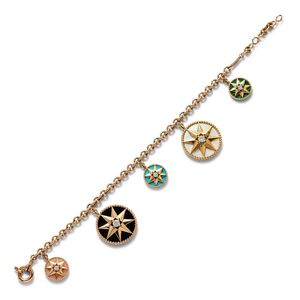Dior 'Rose Des Vents' Gemstone Charm Bracelet with Diamonds
Dior 'Rose Des Vents' gemstone and diamond charm bracelet, Victoire de Castellane, property of a private Sydney collector, composed of a line of trace links supporting five collet-set circular plaques including pink opal, onyx, turquoise, Mother-of-pearl and malachite applied with an eight-point gold star centring a brilliant-cut diamond, the diamonds together weighing approximately 0.38 carats, mounted in 18ct gold, length 180 mm, numbered 1XXXX8, marker's mark, signed Dior., accompanied by a Dior box and papers.
You must be a subscriber, and be logged in to view price and dealer details.
Subscribe Now to view actual auction price for this item
When you subscribe, you have the option of setting the currency in which to display prices to $Au, $US, $NZ or Stg.
This item has been sold, and the description, image and price are for reference purposes only.
- Onyx - Onyx is a form of agate, used from antiquity and popular again in the 1920s and 30s. European onyx is generally green, but can be many other colours, and can contain bands of black and/or white.
This multicoloured stone is widely used for table tops, lamp bases and in jewellery. Some types of onyx are also used for cameos of which the upper white layer is cut away to reveal the colour beneath. - Mother-Of-Pearl - Mother-of-pearl, technical name "nacre", is the inner layer of a sea shell. The iridescent colours and strength of this material were widely used in the nineteenth century as an inlay in jewellery, furniture, (especially papier mache furniture) and musical instruments.
In the early 1900s it was used to make pearl buttons. Mother-of-pearl is a soft material that is easily cut or engraved.
Nowadays it is a by-product of the oyster, freshwater pearl mussel and abalone industries. - Malachite - Malachite is bright copper-green coloured stone with concentric layers which displays distinct contrasting veinings. It has been valued in the past for making or decorating small precious objects such as clocks, jewellery, dishes and so. In the Orient it was used for snuff bottles and in Russia and was favoured by the Faberge workshop. larger pieces were used for table tops.
The principal source of supply was Russia but it is to be found in other regions such as Southern Africa, Mexico, Australia and France.
Malachite glass is a manufactured material that was intended to resemble malachite, but often bears more resemblance to a veined coloured marble due to its lower gloss finish and lack of concentric layers. Malachite glass was manufactured by many glassworks in the 19th century including Loetz in Austria and others in Bohemia and Davidson's Greener's and Sowerby in north eastern England.
It was particularly used for scent bottles, bowls, and small vases often decorated with nymphs.
Malachite glass has been manufactured continuously since the late nineteenth century, most is unmarked and it is difficult to distinguish the age or manufacturer of most commercial pieces.
This item has been included into following indexes:
- bracelets and bangles - mother of pearl 40
- bracelets, gold link type
-
bracelets, gold with gemstones
- gold with diamonds 1,566
- gold with opals 75
- gold, with diamonds 1,466
- bracelets, set with - turquoise 138
- bracelets, silver - silver and malachite 21
- bracelets, type - charm, gold 392
- Dior, Christian (France), item types - jewellery 105
